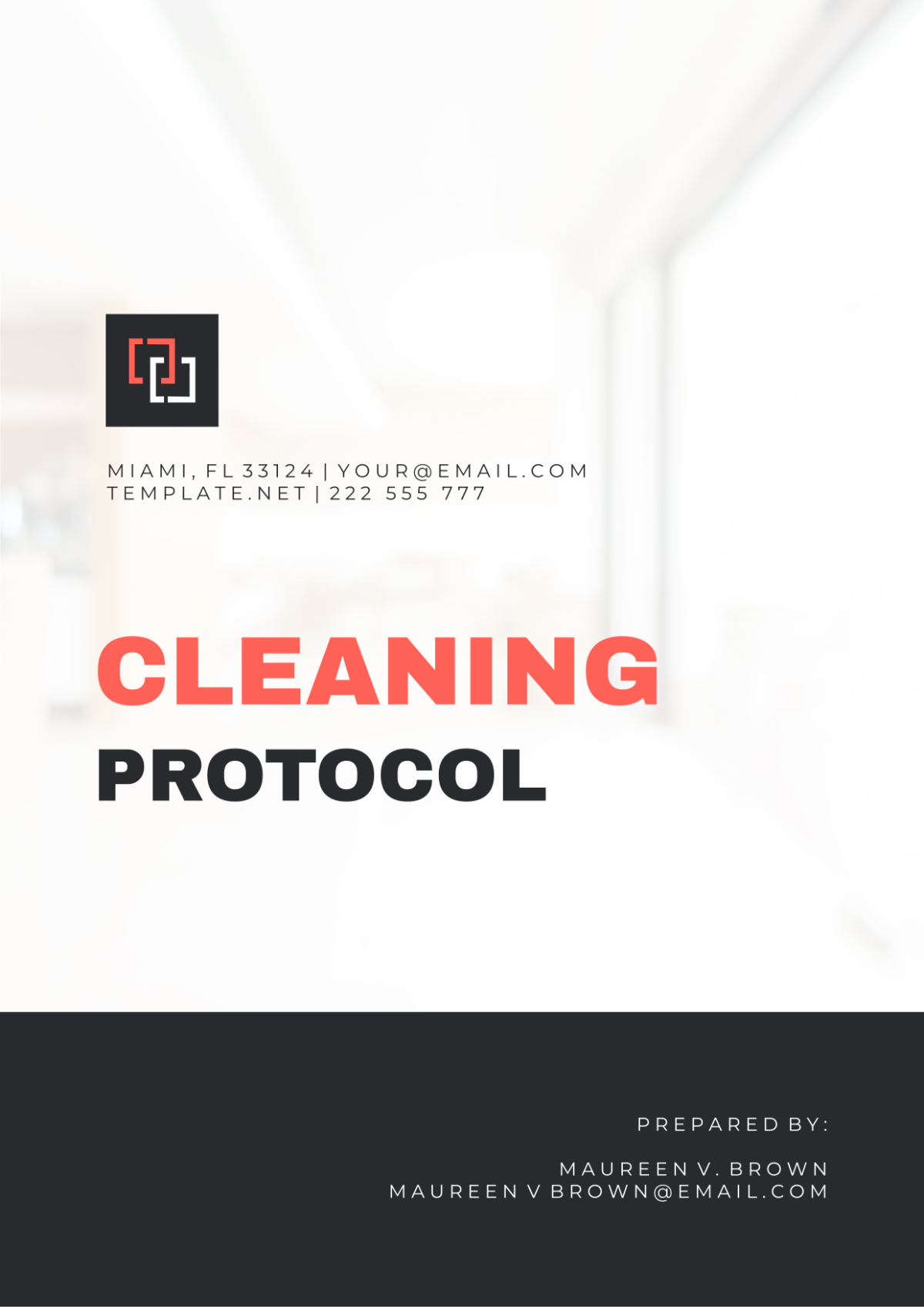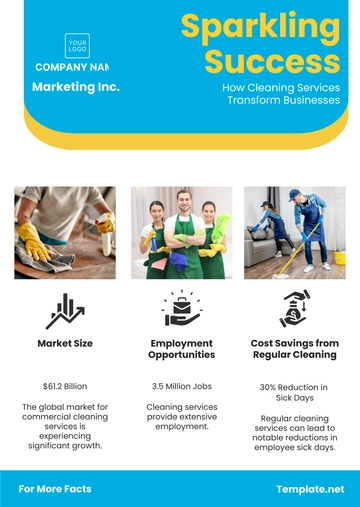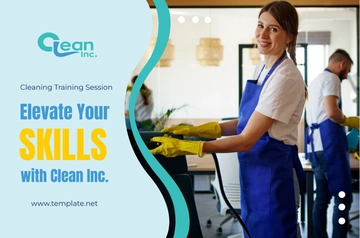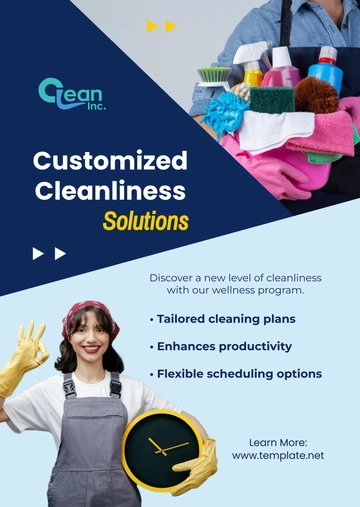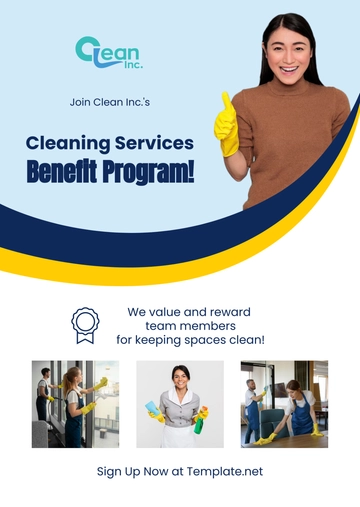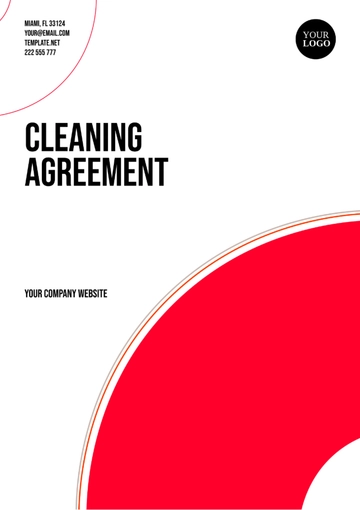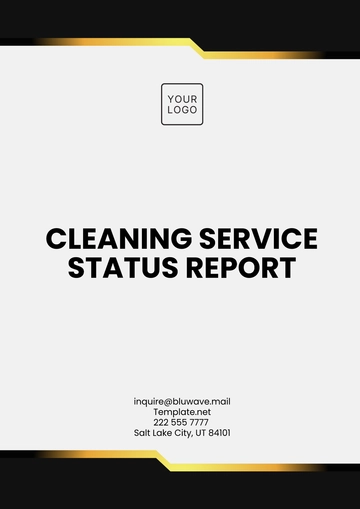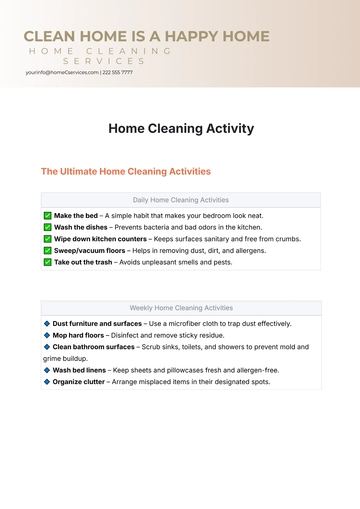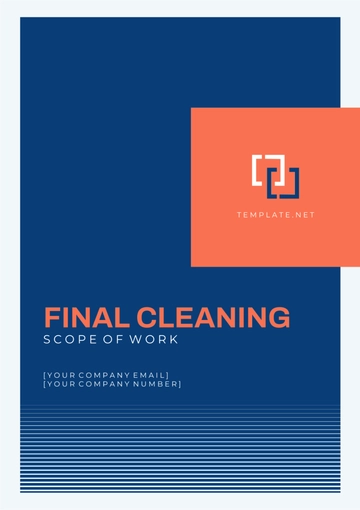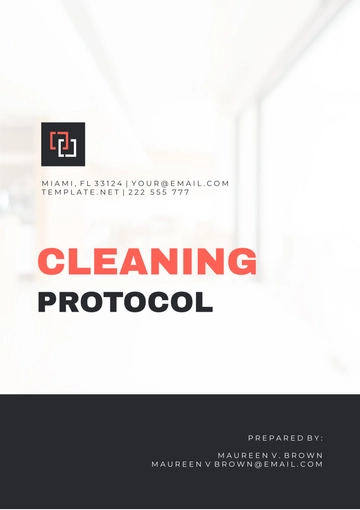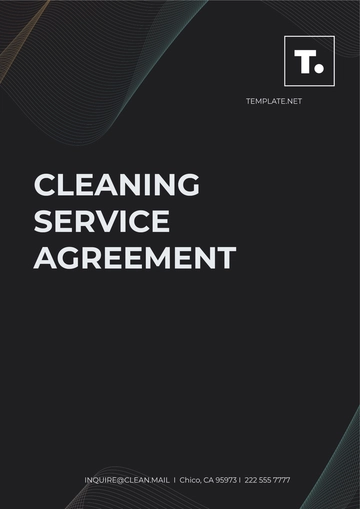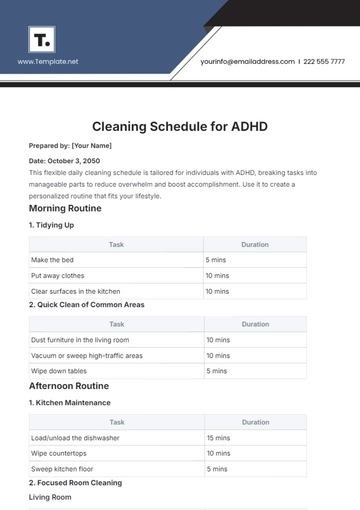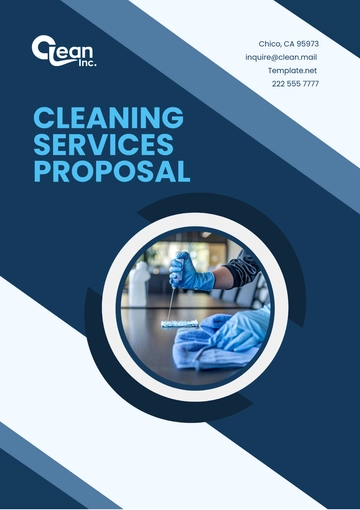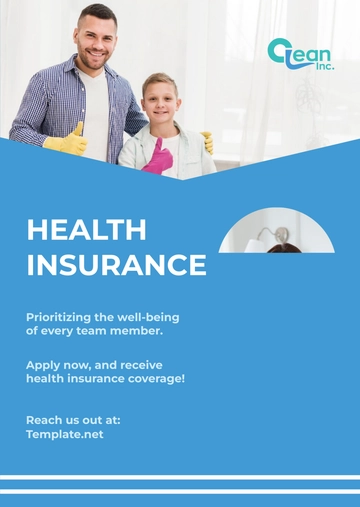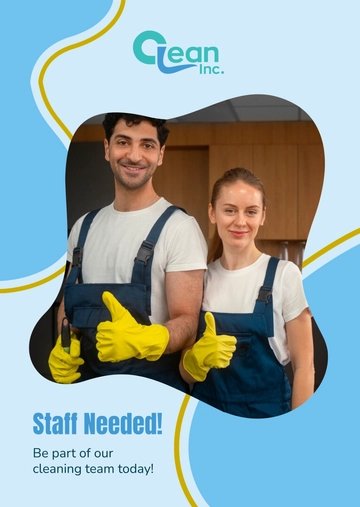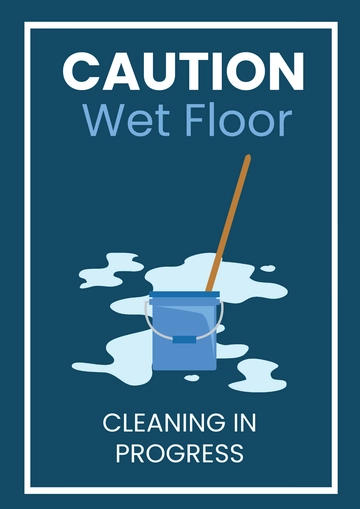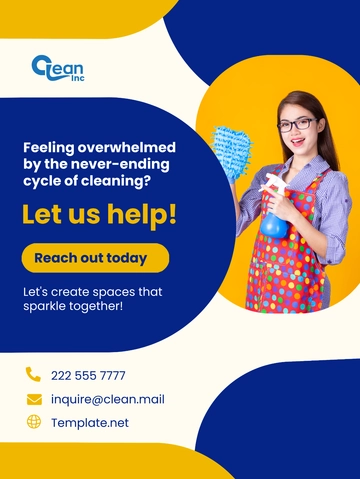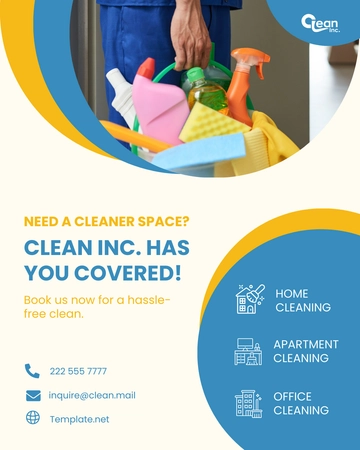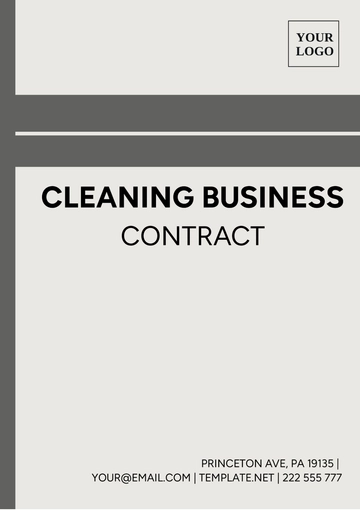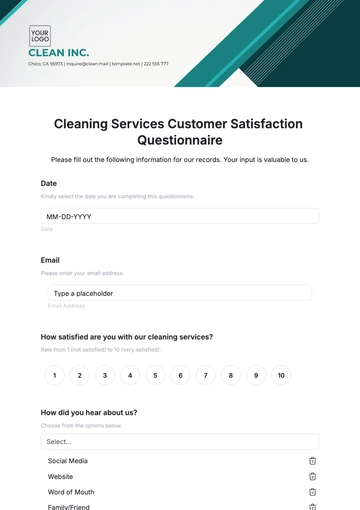CLEANING PROTOCOL
Name: | [Your Name] |
Company Name: | [Your Company Name] |
Date: | [DATE] |
1. Purpose
The Cleaning Protocol is a vital document aimed at maintaining high cleanliness and hygiene standards in our facility. It provides clear guidelines for cleaning, sanitizing, and disinfecting areas, ensuring a safe and healthy environment for all occupants. This protocol underscores the importance of proactive maintenance and ongoing improvement to promote a positive work culture and ensure a clean, welcoming space.
2. Scope
This protocol applies comprehensively to all areas within our facility, ensuring a thorough approach to cleanliness and hygiene management. It covers:
Indoor Areas: This includes offices, meeting rooms, hallways, staircases, elevators, storage areas, kitchens, break rooms, and any other indoor spaces used by occupants. Daily cleaning routines encompass dusting, vacuuming, mopping, and disinfecting surfaces.
Restrooms: Special attention is given to restrooms, with detailed procedures for cleaning fixtures, replenishing supplies, and maintaining hygiene standards to prevent the spread of germs and ensure user comfort.
Outdoor Spaces: While primarily focused on indoor areas, this protocol extends to outdoor spaces such as entryways, parking lots, and smoking areas. Regular cleaning and maintenance help create a positive first impression and promote a clean environment.
Spill and Accident Response: Procedures are in place for immediate response to spills, accidents, or biohazard incidents. This includes using appropriate protective gear, containing the spill, cleaning and disinfecting affected areas, and reporting incidents as per regulatory requirements.
Waste Management: Specific guidelines cover the segregation, handling, and disposal of different types of waste, including recyclables, hazardous materials, and general waste. Proper waste management practices contribute to environmental sustainability and safety.
Sanitation Concerns: Proactive measures address sanitation concerns such as pest control, mold remediation, air quality monitoring, and water system maintenance. Regular inspections and prompt action ensure a healthy and sanitary environment.
Security and Confidentiality: Protocols related to cleaning sensitive areas, handling confidential materials, and respecting privacy ensure security and confidentiality standards are maintained during cleaning activities.
3. Responsibilities
3.1 Facility Management:
Implementation Oversight: Facility managers are responsible for ensuring that the Cleaning Protocol is implemented effectively throughout the facility.
Compliance Monitoring: They monitor and assess compliance with cleaning standards, conduct regular inspections, and address any deviations or deficiencies promptly.
Resource Allocation: Facility managers allocate resources such as cleaning supplies, equipment, and manpower to support efficient cleaning operations.
Training and Support: They provide training, guidance, and support to cleaning staff, ensuring they understand and adhere to the protocol's guidelines.
Continuous Improvement: Facility managers review and update the Cleaning Protocol as needed to incorporate best practices, industry standards, and feedback from stakeholders.
3.2 Cleaning Staff:
Task Execution: Cleaning staff are responsible for executing cleaning tasks according to the guidelines outlined in the Cleaning Protocol.
Quality Assurance: They ensure the quality and thoroughness of cleaning activities, paying attention to detail and addressing areas that require special attention.
Equipment Maintenance: Cleaning staff maintain and properly use cleaning equipment and tools, reporting any issues or malfunctions promptly.
Safety Compliance: They follow safety protocols, use personal protective equipment (PPE) as required, and adhere to environmental and health regulations.
Communication: Cleaning staff communicate effectively with facility management and other stakeholders, reporting completed tasks, identifying issues, and suggesting improvements.
3.3 Employees/Residents:
Cooperation: Employees and residents are expected to cooperate with cleaning staff by keeping their workspaces tidy, following waste disposal guidelines, and reporting spills or maintenance issues promptly.
Compliance: They must comply with additional instructions or protocols related to maintaining cleanliness, such as clearing desks for cleaning, segregating recyclables, or following food safety guidelines in shared areas.
Feedback: Employees and residents are encouraged to provide feedback on cleanliness standards, suggest improvements, and report any concerns regarding the facility's cleanliness.
4. Procedure
Procedure | Description |
|---|
Daily Cleaning | Regularly clean and sanitize high-touch surfaces such as doorknobs, light switches, desks, and countertops using approved cleaning agents. |
Restroom Maintenance | Ensure restrooms are cleaned and stocked with necessary supplies multiple times a day to maintain hygiene standards. |
Waste Management | Dispose of waste properly and regularly, following guidelines for recycling and hazardous waste disposal as applicable. |
Spill Response | Quickly address spills to prevent slips and maintain a clean environment. Use appropriate cleaning materials and follow safety protocols. |
Equipment Maintenance | Regularly inspect and clean cleaning equipment to ensure effectiveness and prevent cross-contamination. |
Reporting | Report any maintenance issues or concerns related to cleanliness to the facility management promptly. |
5. Documentation
Maintain detailed records of cleaning activities, including dates, times, areas cleaned, and any issues encountered. This documentation is crucial for tracking compliance with the Cleaning Protocol, identifying areas for improvement, and demonstrating adherence to cleanliness standards.
6. Training
Provide comprehensive training and resources to cleaning staff on proper cleaning techniques, safety protocols, and the use of cleaning products. Regularly review and update training materials to ensure they reflect current best practices and regulatory requirements. This ongoing training ensures that cleaning staff are equipped with the knowledge and skills necessary to perform their duties effectively and safely.
7. Conclusion
In conclusion, by following this Cleaning Protocol, we create a clean, safe, and healthy environment that promotes productivity, collaboration, and well-being. Your cooperation and commitment are crucial in maintaining our standards and fostering a positive work culture. We appreciate your efforts in upholding cleanliness, contributing significantly to our space's ambiance. Together, we ensure a pleasant and hygienic environment. Thank you for your dedication and attention to these guidelines.
Protocol Templates @ Template.net
